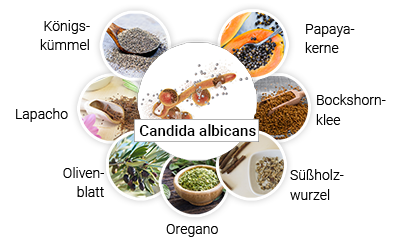Das erste individuelle Diagnostik- und Therapiekonzept



Antikörperdiagnostik
Der FOODSensor CANDIDA & LEAKY GUT Blutuntersuchung weist eine Immunreaktion auf Candida albicans im Serum nach und testet außerdem sieben ausgewählte Naturstoffe, die für eine Behandlung gegen Candida und Leaky-Gut-Syndrom geeignet sein können.



Individuelle Phytomischung
für anti-mykotische, anti-inflammatorische, anti-oxidative und präbiotische Behandlungs- optionen bei Candida albicans und Leaky Gut oder Einzelsubstanzen aus der Apotheke bzw. dem Naturkostladen.

Die FOODSensor CANDIDA & LEAKY GUT Ergebnisse zeigen, welche der getesteten Naturstoffe im individuellen Fall proinflamatorisch wirken können und daher nicht für eine Behandlung geeignet sind. Die als geeignet getesteten Naturstoffe können (z.B. als individuelle Phytomischung) für die Therapie verwendet werden.
Info-Paket anfordern
Das Info-Paket enthält:
- Musterbefund
- Naturstoff-Broschüre
- Laborschein mit Blutabnahmeset
- Kennenlern-Aktion

Probleme der bisherigen Diagnostik- und Therapieoptionen
Der pathologische Befall mit dem Hefepilz Candida albicans gehört zu den problematischen Erkrankungen, da er in der Stuhldiagnostik aufgrund der schwierigen Prä-Analytik nicht verlässlich diagnostiziert werden kann und nur eingeschränkte Therapieoptionen zur Verfügung stehen, die häufig nicht nachhaltig wirken.
Dabei steht Candida albicans im Verdacht eine Vielzahl von Symptomen zu erzeugen und manifeste Erkrankungen zu fördern, wie z.B.:
- Beschwerden im Magen-Darmtrakt, wie Diarrhöen, Obstipation, Blähungen u.a.
- Leaky-Gut-Syndrom und Darmentzündungen
- Müdigkeit
- Oberbauchbeschwerden
- Gelenkbeschwerden, Muskelschmerzen
- Juckreiz und Hautausschlag
- Kopfschmerzen
- Nahrungsmittel-Überempfindlichkeiten

Unsere ganzheitliche und individuelle Lösung zum Wohle Ihrer Patienten
Aufgrund der schwierigen Diagnose- und Therapielage haben wir den neuen FOODSensor CANDIDA & LEAKY GUT – Test entwickelt, der nicht nur den immunologischen Nachweis auf Candida im Serum führt, sondern gleichzeitig auch sieben Naturstoffe testet, die nach aktuellen Studien* (in vivo und in vitro) besonders effektiv gegen sogar Antibiotika-resistente Varianten von Candida albicans wirken können.
So können Sie einen Patienten mit Phytotherapeutika behandeln, die keine unerwünschte pro-inflammatorische Reaktion auslösen.
Eine weitere Besonderheit ist, dass diese Naturstoffe nicht nur eine anti-mykotische Wirkung haben, sondern auch positive Eigenschaften in der Behandlung des Leaky-Gut-Syndroms zeigen und anti-inflammatorisch und präbiotisch wirken können*.
”Mit diesem Diagnostik- und Therapiekonzept haben wir in unserer Praxis endlich gute diagnostische Möglichkeiten und eine Behandlung mit Naturstoffen entspricht unserem Verständnis einer nachhaltigen Therapie.
Dr. Ulrich KraftHeilpraktiker aus Fulda
Sie möchten weitere Informationen erhalten?
Kontakt
Kontakt zum Labor:
Telefon: 0251 – 208 358 60
Email: info@food-sensor.de
*Studiennachweis: (Bitte aufklappen)
Pereira, I.T., et al. 2012. Antiulcer Effect of Bark Extract of Tabebuia avellanedae: Activation of Cell Proliferation in Gastric Mucosa During the Healing Process. Phytotherapy Research, DOI: 10.1002/ptr.4835 • Zhang, L., et al. 2016. Anti-inflammatory cyclopentene derivatives from the inner bark of Tabebuia avellanedae. Fitoterapia 109:217-223 • Zhang, L., et al. 2017. Iridoid Esters from Tabebuia avellanedae and Their In Vitro Anti-inflammatory Activities. Planta Med. 83(1-02):164-171 • Park, H. J., et al. 2017. Oral administration of taheebo (Tabebuia avellanedae Lorentz ex Griseb.) water extract prevents DSS-induced colitis in mice by up-regulating type II T helper immune responses BMC Complementary and Alternative Medicine 17:448 • Ma, S., et al. 2017. Taheebo Polyphenols Attenuate Free Fatty Acid-Induced Inflammation in Murine and Human Macrophage Cell Lines As Inhibitor of Cyclooxygenase-2. Front. Nutr. 4:63 • Lee, M.H., et al. 2012. Analgesic and anti-inflammatory effects in animal models of anethanolic extract of Taheebo, the inner bark of Tabebuia avellanedae. Molecular Medicine Reports 6: 791-796 • Byeon, S.E., et al. 2008. In vitro and in vivo anti-inflammatory effects of taheebo, a water extract from the inner bark of Tabebuia avellanedae. J Ethnopharmacol. 119(1):145-152 • Höfling, J.F., et al. 2010. Antimicrobial potential of some plant extracts against Candida species. Braz. J. Biol. 70( ): 1065-1068 • Portillo, A., et al. 2001. Antifungal activity of Paraguayan plants used in traditional medicine. Journal of Ethnopharmacology 76:93-98 • Prema, A., et al. 2017. Fenugreek Seed Powder Attenuated Aluminum Chloride-Induced Tau Pathology, Oxidative Stress, and Inflammation in a Rat Model of Alzheimer’s Disease. J Alzheimers Dis. 60(s1):S209-S220 • Majeed, M., et al. 2018. Galactomannan from Trigonella foenum-graecum L. seed: Prebiotic application and its fermentation by the probiotic Bacillus coagulans strain MTCC 5856. Food Sci Nutr. 6(3):666-673 • Sharma, N., et al. 2017. Trigonella seed extract ameliorates inflammation via regulation of the inflammasome adaptor protein, ASC. Front Biosci (Elite Ed). 9:246-257 • Pundarikakshudu, K., et al. 2016. Anti-inflammatory activity of fenugreek (Trigonella foenum-graecum Linn) seed petroleum ether extract. Indian J Pharmacol. 48(4):441-444 • Joshi, D.V., et al. 2015. Hydroalcohol extract of Trigonella foenum-graecum seed attenuates markers of inflammation and oxidative stress while improving exocrine function in diabetic rats. Pharm Biol. 53(2):201-211 • Sindhu, G., et al. 2012. Anti-inflammatory and antioxidative effects of mucilage of Trigonella foenum graecum (Fenugreek) on adjuvant induced arthritic rats. Int Immunopharmacol. 12(1):205-211 • Varadarajan, S., et al. 2015. Invitro Anti-mycotic Activity of Hydro Alcoholic Extracts of Some Indian Medicinal Plants against Fluconazole Resistant Candida albicans. Journal of Clinical and Diagnostic Research 9(8): ZC07-ZC10 • Khan, S., et al. 2017. Antimicrobial activity of various ethanolic plant extracts against pathogenic multi drug resistant Candida spp. Bioinformation 13(3): 67-72 • R. Shruthi. R.R., et al. 2017. Structural and functional characterization of a novel immunomodulatory glycoprotein isolated from ajowan (Trachyspermum ammi L.). Glycoconj J 34:499–514 • Singh, A., et al. 2017. Antioxidant Activity of Essential Oil Extracted by SC-CO2 from Seeds of Trachyspermum ammi. Medicines 4:53 • Goswami, N., et al. 2014. Assessment of Free Radical Scavenging Potential and Oxidative DNA Damage Preventive Activity of Trachyspermum ammi L. (Carom) and Foeniculum vulgare Mill. (Fennel) Seed Extracts. BioMed Research International, Article ID 582767, 8 pages • Thangam, C., et al. 2003. Antiinflammatory potential of the seeds of Carum copticum Linn. Indian Journal of Pharmacology 35:388-391 • Bora, L. 2016. Anticandidal activity of medicinal plants and Pseudomonas aeruginosa strains of clinical Specimens. Journal of Microbiology, Immunology and Infection 49:276e280 • Sharifzadeh A, et al. 2016. Antifungal activity of essential oils from Iranian plants against fluconazole-resistant and fluconazole-susceptible Candida albicans. Avicenna J Phytomed 6(2):215-222 • Khan, R., et al. 2010. Activity of solvent extracts of Prosopis spicigera, Zingiber officinale and Trachyspermum ammi against multidrug resistant bacterial and fungal strains. J Infect Dev Ctries. 4(5):292-300 • Chavez-Quintal, P. et al. 2011. Antifungal Activity in Ethanolic Extracts of Carica papaya L. cv. Maradol Leaves and Seeds. Indian J Microbiol 51(1):54-60 • Somanah, J., et al. 2017. Extracts of Mauritian Carica papaya (var. solo) protect SW872 and HepG2 cells against hydrogen peroxide induced oxidative Stress. J Food Sci Technol 54(7):1917-1927 • Pandey, S., et al. 2016. Anti-inflammatory and immunomodulatory properties of Carica papaya. Journal of immunotoxicology 13(4):590–602 • Abdullah, M., et al. 2011. Carica papaya increases regulatory T cells and reduces IFN-γ+ CD4+ T cells in healthy human subjects. Mol Nutr Food Res. 55(5):803-806 • Zhang, T. et al. The Candida albicans Inhibitory Activity of the Extract from Papaya (Carica papaya L.) Seed Relates to Mitochondria Dysfunction. Int. J. Mol. Sci. 18:1858 • He, X. et al. 2017. Chemical composition and antifungal activity of Carica papaya Linn. seed essential oil against Candida spp. Lett Appl Microbiol. 64(5):350-354 • Varadarajan, S., et al. 2015. Invitro Anti-mycotic Activity of Hydro Alcoholic Extracts of Some Indian Medicinal Plants against Fluconazole Resistant Candida albicans. Journal of Clinical and Diagnostic Research 9(8): ZC07-ZC10 • Sultan, M.T., et al. 2014. Immunity: Plants as Effective Mediators. Critical Reviews in Food Science and Nutrition 54:1298-1308 • Peterson, C.T., et al. 2018. Prebiotic Potential of Herbal Medicines Used in Digestive Health and Disease. J Altern Complement Med. 24(7):656-665 • Sharma, H. et al. 2016. Antifungal efficacy of three medicinal plants Glycyrrhiza glabra, Ficus religiosa, and Plantago major against oral Candida albicans: A comparative analysis. Indian J Dent Res 27:433-436 • De Oliveira, J.R., et al. 2013. Cytotoxicity of Brazilian plant extracts against oral microorganisms of interest to dentistry. BMC Complementary and Alternative Medicine 13:208 • Fatima, A. et al. 2009. Antifungal Activity of Glycyrrhiza glabra Extracts and its Active Constituent Glabridin. Phytother. Res. 23:1190-1193 • Irani, M., et al. 2010. Leaves Antimicrobial Activity of Glycyrrhiza glabra L. Iranian Journal of Pharmaceutical Research 9(4):425-428 • Rucklidge, J.J. 2013. Could Yeast Infections Impair Recovery From Mental Illness? A Case Study Using Micronutrients and Olive Leaf Extract for the Treatment of ADHD and Depression. ADVANCES, SUMMER 2013, 27(3):14-18 • Kiraz, A., et al. 2016. Investigation of the effects of oleuropein rich diet on rat enteric bacterial flora. Bratisl Med J 117 (12):734 – 737 • Debib, A., et al. 2017. Phenolic Content, Antioxidant and Antimicrobial Activities of “Chemlali” Olive Leaf (Olea europaea L.) Extracts • Vezza, T. et al. 2017. Immunomodulatory properties of Olea europaea leaf extract in intestinal inflammation. Mol Nutr Food Res. 61(10). doi: 10.1002/mnfr.201601066. Epub 2017 Aug 29. • Mehmood, A., et al. 2018. Phenolic contents, antimicrobial and antioxidant activity of Olea ferruginea Royle (Oleaceae). BMC Complementary and Alternative Medicine 18:173 • Noric, N., et al. 2016. Olive leaf extract activity against Candida albicans and C. dubliniensis – the in vitro viability study. Acta Pharm. 66 (2016) 411–421 • Markin, D., et al. 2003. In vitro antimicrobial activity of olive leaves. Mycoses. 46(3-4):132-136 • Nasrollahi, Z., et al. 2015. Evaluation of the antifungal activity of olive leaf aqueous extracts against Candida albicans PTCC-5027. Curr Med Mycol 1(4): 37-39
